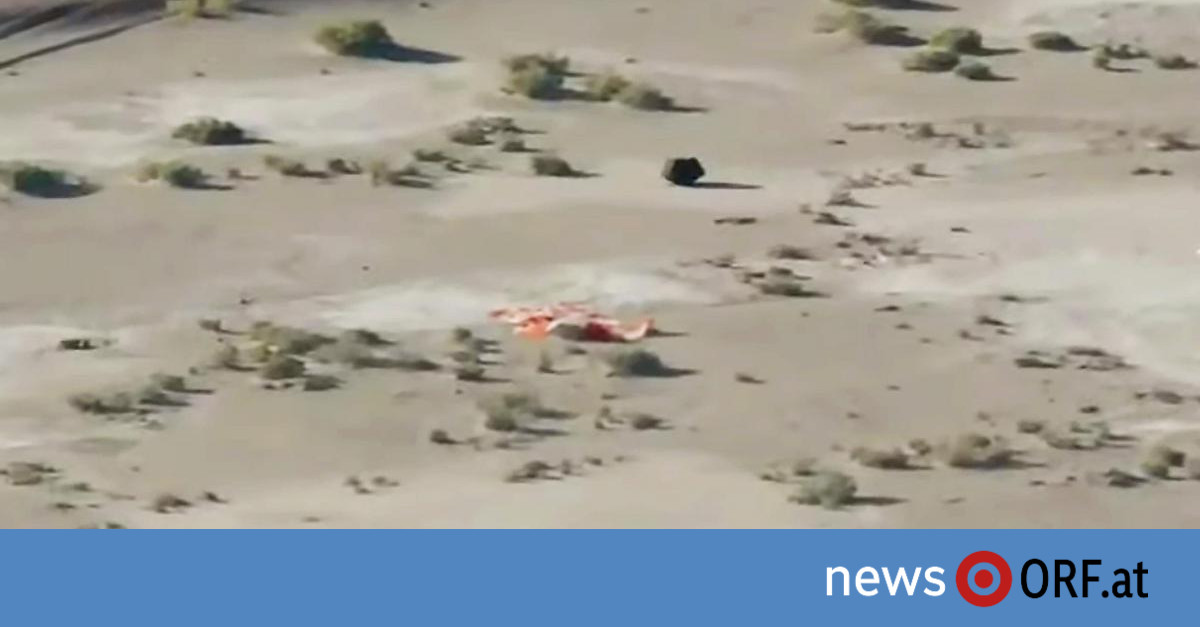The capsule, protected by a heat shield and slowed by parachutes, landed on a military site in the desert in the US state of Utah about three minutes before scheduled time. “The OSIRIS-REX sample capsule lands.” “The billion-mile journey to asteroid Bennu and back has ended,” a NASA spokesperson said Sunday during a live broadcast of the landing.
The capsule, with a diameter of just over 80 centimeters, was previously dropped from the OSIRIS-REX space probe at an altitude of about 100,000 kilometers above the Earth. According to NASA estimates, the capsule contains about 250 grams of rock and dust samples collected on Bennu about three years ago.

He was brought to a “sterile room” by helicopter
After landing, the NASA team carefully transported the capsule by helicopter to a temporary “sterile chamber” nearby to avoid contamination of the sample with desert sand, which could confound test results. On Monday, the capsule will be brought to the Johnson Space Center in Houston (US state of Texas) – where about 200 scientists will work on the sample using 60 different examination methods.
If the capsule’s contents turn out to be as NASA hopes, it will be the first asteroid sample successfully brought to Earth in the US space agency’s history — and perhaps the largest such sample ever taken. In 2005, the Japanese space probe Hayabusa landed on an asteroid. In 2010, the first soil samples collected from this celestial body were brought to Earth. There have been other flights to asteroids, but no other probe has been able to return material to Earth yet.
NASA wants to ‘better understand types of asteroids’
OSIRIS-REX (short for: Origins, Spectral Interpretation, Resource Identification, Security-Regolith Explorer) was launched from Cape Canaveral Spaceport in September 2016 and arrived at Bennu about two years later.
In October 2020, the probe took samples of rocks and dust from the asteroid in a complex maneuver that lasted several hours. The maneuver didn’t go exactly as planned: The lid of the collection container was opened slightly by larger stones, allowing parts of the sample to escape. However, NASA scientists still assume that there is enough material in the collection container.

Space Agency President Bill Nelson said the material collected by Bennu will help NASA “better understand the types of asteroids that could threaten Earth.” They can also provide information about the formation of the solar system.
An asteroid with a diameter of about 550 metres
Deep Black Bennu, named after an ancient Egyptian god, is about 550 meters in diameter and could come completely close to Earth in 150 years. Although the risk of collision is very low, NASA considers Bennu one of the most dangerous asteroids currently known – and therefore wants to conduct detailed research on it. Scientists also hope that the OSIRIS-REX mission will provide insights into the formation of the solar system more than 4.5 billion years ago, because asteroids are remnants of it.
Next destination: Apophis
The “OSIRIS-REx” probe, which is approximately six meters long and weighs 2,100 kilograms, set off again towards the next asteroid, “Apophis,” immediately after the return capsule was dropped. According to calculations, the asteroid with a diameter of about 370 meters will pass near Earth at a distance of about 32 thousand kilometers in 2029, and thus it can be studied closely for the first time. The mission has already been extended for at least nine years, and will then have a new name, “OSIRIS-APEX” (OSIRIS-APophis EXplorer).


